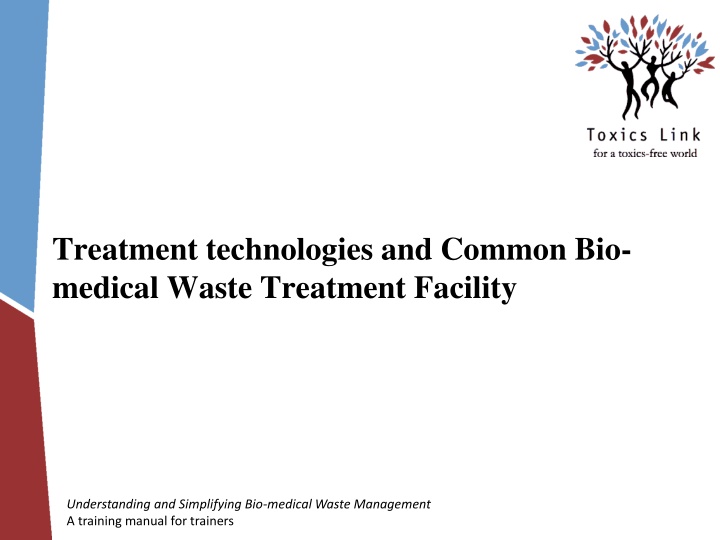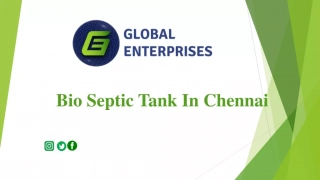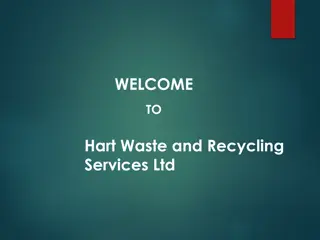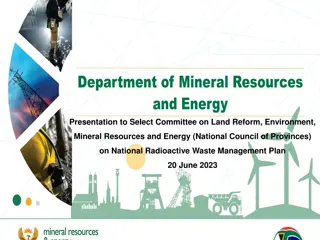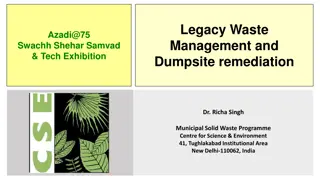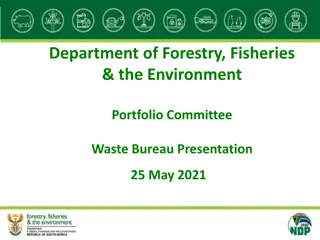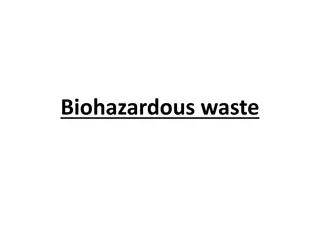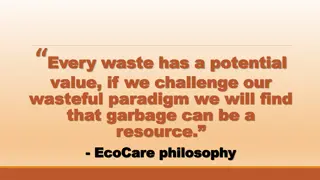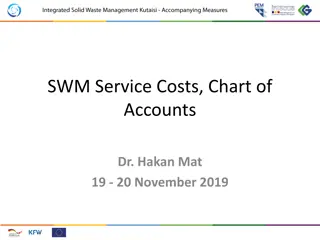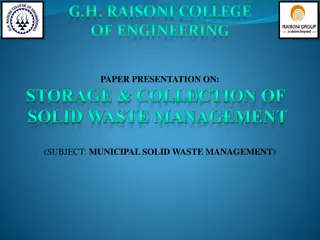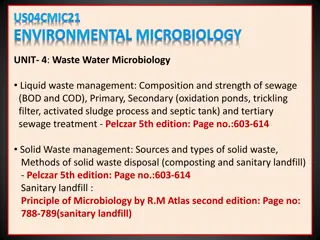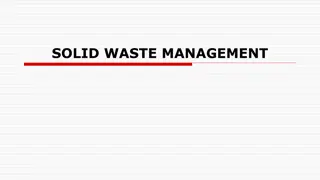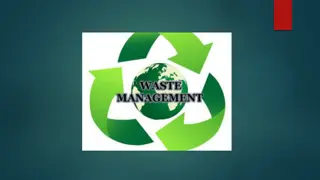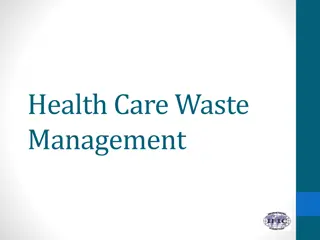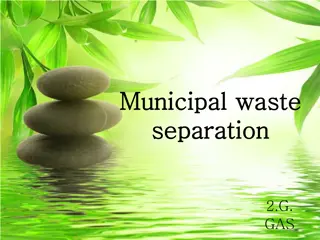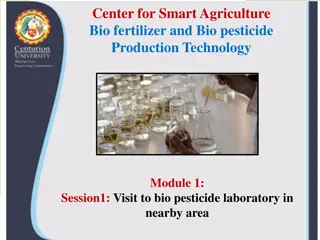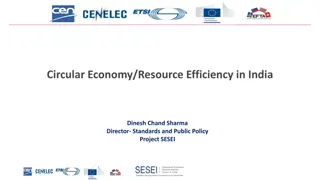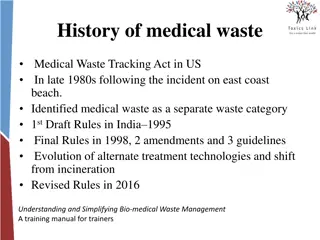Simplifying Bio-medical Waste Management Strategies
A common bio-medical waste treatment facility (CBWTF) is an essential setup for centrally treating and managing biomedical waste generated from healthcare units. This training manual covers draft guidelines, technologies used such as autoclave, types of autoclave, stages in autoclave operation, and standards for waste autoclaving.
Download Presentation

Please find below an Image/Link to download the presentation.
The content on the website is provided AS IS for your information and personal use only. It may not be sold, licensed, or shared on other websites without obtaining consent from the author.If you encounter any issues during the download, it is possible that the publisher has removed the file from their server.
You are allowed to download the files provided on this website for personal or commercial use, subject to the condition that they are used lawfully. All files are the property of their respective owners.
The content on the website is provided AS IS for your information and personal use only. It may not be sold, licensed, or shared on other websites without obtaining consent from the author.
E N D
Presentation Transcript
Treatment technologies and Common Bio- medical Waste Treatment Facility Understanding and Simplifying Bio-medical Waste Management A training manual for trainers
Introduction A common bio-medical waste treatment facility (CBWTF) is a set up where biomedical waste, generated from a number of healthcare units, is treated centrally. A CBWTF should have all the required technologies to collect, treat and dispose Bio- medical waste. Understanding and Simplifying Bio-medical Waste Management A training manual for trainers
Draft Guidelines for CBWTF The guidelines are laid by Central Pollution control board. Salient features: Every CBWTF must have treatment equipments like incinerator, autoclave or microwave, shredder and effluent treatment plant as a part of treatment, prior to commencement of its operation. It should collect, transport, treat and dispose segregated Bio medical waste of all Healthcare Facilities within 75 km range. Operator of a CBWTF should maintain a record of recyclable wastes The record shall be open for inspection by the prescribed authorities It shall allow visit by any occupier Bar code and global positioning system should be used by CBWTF All the CBWTF vehicles should be labeled as given in part A of the Schedule IV of the Bio-medical waste management Rules Understanding and Simplifying Bio-medical Waste Management A training manual for trainers
Technologies used in a CBWTF Autoclave It is a low heat thermal process and it uses steam for disinfection of waste. It uses different temperature, pressure and time combinations for a treatment cycle. Understanding and Simplifying Bio-medical Waste Management A training manual for trainers
Types of Autoclave Air is an effective insulator, thus complete disinfection demands removal of air from the chamber. Two methods of removing air are: Gravity displacement Pre-vacuum Understanding and Simplifying Bio-medical Waste Management A training manual for trainers
Stages in autoclave operation Pre-heating Loading of waste with an indicator Air evacuation Steam treatment Steam discharge Unloading Mechanical treatment Understanding and Simplifying Bio-medical Waste Management A training manual for trainers
Standards for waste autoclaving Dedicated autoclave for waste treatment Time, temperature and pressure to the maintained Graphic/computer recording devices Validation test: Spore testing (bacillus stearothermophilus with atleast 1x104 spores/ml) Routine test: chemical indicator strip/tape which is colour sensitive. Operating parameters Gravity flow: 121oC, 15psi, 60`; 135oC, 31psi,45`; 149oC, 52psi, 30` Pre-vacuum: 121oC, 15psi, 45`; 135oC, 31psi, 30` Understanding and Simplifying Bio-medical Waste Management A training manual for trainers
Types of waste allowed/ disallowed Waste Allowed Yellow Category waste: Under this, soiled waste: items contaminated with blood and body fluids, including cotton dressings, soiled plaster casts, linen, beddings, etc. Red Category Contaminated Waste (Recyclables) - waste generated from disposable items other than the waste sharps, such as tubings, catheters, intravenous sets, syringes (without needles or fixed needles syringes), vaccutainers with their needles cut etc. White Category (Translucent) - Waste sharps including metals: needles, syringes, scalpels, blades, glass etc. that may cause puncture and cuts. This includes both used and unused sharps. Blue Category Glassware Broken or discarded & contaminated glass including medicine vials and ampoules except those contaminated with cytotoxic wastes. Not to be treated: Volatile and semi-volatile organic compounds Chemotherapeutic wastes, mercury and other hazardous chemical waste Radiological waste, Sealed heat resistant containers Human/ Animal Anatomical Waste Microbiological/Biotechnological Waste Huge and bulky bedding material Understanding and Simplifying Bio-medical Waste Management A training manual for trainers
Points to remember Segregated waste is a must Air evacuation is necessary Place bags in multi-load trays Proper ventilation to avoid odors Thermocouples and pressure gauges should be checked frequently Understanding and Simplifying Bio-medical Waste Management A training manual for trainers
Microwaves: action mechanism Disinfection by moist heat and steam generated by microwave energy Magnetrons convert high voltage electrical energy into microwave energy The microwaves create an electromagnetic field Water and other molecules in waste try to align in the field and in the process they vibrate Vibration of the molecules produces heat Understanding and Simplifying Bio-medical Waste Management A training manual for trainers
Microwaves: action mechanism Microwave kills by two mechanisms: By heat energy from the steam generated Changing the biological molecular structure of proteins Microwaves are high frequency (2450+50mhz) radio waves capable of creating electromagnetic field Temperatures reached are around 97-100oC. In some new systems, steam under pressure is passed, to achieve temperatures>135oC. Cycle time is around 25` Typically, around 2-6 magnetrons are used with an output of about 1.2KW each Understanding and Simplifying Bio-medical Waste Management A training manual for trainers
Stages in microwave operations Waste loading Steam injection in the hopper Internal shredding Microwave treatment Disinfection cycle Optional secondary shredding Discharge Category of waste that can be and cannot be treated is similar to the autoclave. Emission parameters are also similar Understanding and Simplifying Bio-medical Waste Management A training manual for trainers
Advantages and disadvantages Advantages In use for more than a decade Minimal emissions if no hazardous waste fed Automated system No liquid effluent Disadvantages Relatively high capital cost Toxic emissions if hazardous waste fed Any large metal item can damage shredders Odour problems Probability of microwave energy leakage Understanding and Simplifying Bio-medical Waste Management A training manual for trainers
Standards for microwaves Not to be used for cytotoxic, hazardous or radioactive wastes, contaminated animal carcasses, body parts and large metal items Should comply with efficacy and routine tests and should consistently kill bacteria and other pathogenic organisms Biological indicator: bacillus subtilis spores (using strips/vials of 1x104spores/ml) Understanding and Simplifying Bio-medical Waste Management A training manual for trainers
Hydroclave Hydroclave is steam treatment with fragmentation and drying of waste It has a double walled chamber with an agitator inside Steam is injected into this wall (jacket) and waste is loaded in the inner chamber The agitator fragments and turns waste Understanding and Simplifying Bio-medical Waste Management A training manual for trainers
Hydroclave: treatment mechanism The moisture in the waste turns to steam and exerts pressure on the inner walls. If this pressure is not sufficient, additional steam may be injected inside. Cycle runs at 132oC for 15`/ 121oC for 30` Finally the steam is vented through a condenser while maintaining heat input, causing the waste to dry Steam is shut off, discharge door is opened and agitator runs in reverse rotation to place the waste on a conveyor belt/ container Understanding and Simplifying Bio-medical Waste Management A training manual for trainers
Advantages and disadvantages Advantages o Shredded, dry waste o Internal mixing improves transfer of heat Disadvantages o Clogging of agitator blades with waste o Mixed shredded waste makes recycling difficult Understanding and Simplifying Bio-medical Waste Management A training manual for trainers
Plasma Pyrolysis & Gasification: Action Mechanism This process converts organic matter into synthetic gas, electricity, and slag using plasma. A plasma torch powered by an electric arc, is used to ionize gas and catalyze organic matter into synthetic gas and solid waste (slag) A strong electric current under high voltage passes between the two electrodes as an electric arc. Pressurized inert gas is ionized passing through the plasma created by the arc. The torch's temperature ranges from 4,000 to 25,000 F (2,200 to 13,900 C). The waste is heated, melted and finally vaporised. Understanding and Simplifying Bio-medical Waste Management A training manual for trainers
Dry Heat Sterilization: Action Mechanism This system uses heated air at high speed. After the waste is loaded, it is shredded and then transferred to a treatment chamber. Hot air is directed in a way that causes the waste particles to rotate turbulently around a vertical axis in a torroidal mixing action. This causes high rates of heat exchange and within four to six minutes, dry unrecognisable waste is ejected. The type of waste to be treated and emission problems with this system are similar to those of autoclaves. This technology requires a temperature of 185 C for a residence time of 150 minutes, with a sterilization period of 90 minutes. Understanding and Simplifying Bio-medical Waste Management A training manual for trainers
Incineration Incineration is a burn technology and high temperatures are used to kill the pathogens and, in the process, destroy the materials on which they reside. During incineration and post combustion cooling, waste components dissociate and recombine, forming hundreds and thousands of new molecules, which are referred to as products of incomplete combustion (PIC). Theoretically, an incinerator would change all hydrocarbons to carbon- dioxide and water, but this does not happen in practice Understanding and Simplifying Bio-medical Waste Management A training manual for trainers
Incineration Standards S.N o. 1 2 Parameter Standards Conc. (mg/Nm3) 50 400 Particulate matter Nitrogen Oxides NO and NO2 expressed as NO2 HCl Total Dioxins and Furans 50 0.1ngTEQ/Nm3 (at 11% O2) 0.05 3 4 Hg and its compounds 5 Temperature o Primary Chamber-800+/-50oC o Secondary Chamber- 1000+/-50oC Secondary chamber gas residence time atleast 2 seconds, with minimum 3% oxygen in the stack gas Minimum Stack height shall be 30 meters above ground Volatile organics in ash not more than 0.01% Suitable pollution control equipment to achieve emission levels Understanding and Simplifying Bio-medical Waste Management A training manual for trainers
Dioxins: where do they come from? Are an unintentional by product of waste incineration, as well as certain chemical and manufacturing processes; Are toxic at very low levels of exposure Are persistent in the environment Bio-accumulate Have a half-life of approximately 7 years in humans, 100 years in sub-surface soil and over 50 years in water bodies and sediments Understanding and Simplifying Bio-medical Waste Management A training manual for trainers
Medical waste incineration and dioxins Medical waste incinerators are a major source of dioxins in the global environment Burning of chlorine-containing material such as chlorinated plastics result in dioxins Dioxins are formed after combustion, during the cooling of the exhaust gases Polyvinyl chloride (PVC) is a major source of chlorine in medical waste Understanding and Simplifying Bio-medical Waste Management A training manual for trainers
Human health effects of dioxin Cancer o increased cancer mortality Neo-natal abnormalities o change in Sex Ratio o altered level of thyroid hormone Skin disorders o porphyria cutanea tarda o chloracne Understanding and Simplifying Bio-medical Waste Management A training manual for trainers
Human health effects of dioxin Immune system Changes/suppression in immune system Endocrine (hormone) system effects Low levels of testosterone Increase in glucose tolerance Decreased estrogen and estrogen-receptor levels after foetal exposure
Ash Incinerator ash is hazardous waste Needs to be disposed in secured landfills Problems are: Contamination with heavy metals (lead, cadmium and mercury) Loaded with dioxins and furans Pollution control equipment increase toxicity of ash Understanding and Simplifying Bio-medical Waste Management A training manual for trainers
